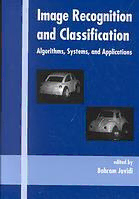
Image recognition and classification PDF
Preview Image recognition and classification
ISBN:0-8247-0783-4 Thisbookis printedonacid-free paper. Headquarters MarcelDekker, Inc. 270Madison Avenue,New York, NY 10016 tel:212-696-9000; fax:212-685-4540 Eastern Hemisphere Distribution MarcelDekker AG Hutgasse 4, Postfach812, CH-4001Basel, Switzerland tel:41-61-261-8482; fax:41-61-261-8896 WorldWideWeb http://www.dekker.com The publisher offers discounts on this book when ordered in bulk quantities. For moreinformation,writetoSpecialSales/ProfessionalMarketingattheheadquarters addressabove. Copyright #2002byMarcelDekker, Inc. AllRights Reserved. Neitherthisbooknoranypartmaybereproducedortransmittedinanyformorby any means, electronic or mechanical, including photocopying, microfilming, and recording, or by any information storage and retrieval system, without permission in writing from the publisher. Current printing (last digit): 109 87 6 5 4 32 1 PRINTED IN THE UNITED STATESOF AMERICA Image Recognition and Classification Algorithms, Systems, and Applications edited by Bahram Javidi University of Connecticut Storrs, Connecticut Marcel Dekker, Inc. New York Basel • TM Copyright ©2001 by Marcel Dekker,Inc. All Rights Reserved. For my Aunt Matin Preface Image recognition and classification is one of the most actively pursued areas in the broad field of imaging sciences and engineering. The reason is evident: the ability to replace human visual capabilities with a machine is very important and there are diverse applications. The main idea is to inspect an image scene by processing data obtained from sensors. Such machines can substantially reduce the workload and improve accuracy of makingdecisionsbyhumanoperatorsindiversefieldsincludingthemilitary and defense, biomedical engineering systems, health monitoring, surgery, intelligent transportation systems, manufacturing, robotics, entertainment, and security systems. Image recognition and classification is a multidisciplinary field. It requires contributions from diverse technologies and expertise in sensors, imaging systems, signal/image processing algorithms, VLSI, hardware and software, and packaging/integration systems. Inthemilitary,substantialeffortsandresourceshavebeenplaced inthis area. The main applications are in autonomous or aided target detection and recognition, also known as automatic target recognition (ATR). In addition, a variety of sensors have been developed, including high-speed video, low-light-level TV, forward-looking infrared (FLIR), synthetic aper- ture radar (SAR), inverse synthetic aperture radar (ISAR), laser radar (LADAR), multispectral and hyperspectral sensors, and three-dimensional sensors. Image recognition and classification is considered an extremely useful and important resource available to military personnel and opera- tions in the areas of surveillance and targeting. In the past, most image recognition and classification applications have beenformilitaryhardwarebecauseofhighcostandperformancedemands. With recent advances in optoelectronic devices, sensors, electronic hard- ware,computers,andsoftware,imagerecognitionandclassificationsystems have become available with many commercial applications. v vi Preface While there have been significant advances in image recognition and classification technologies, major technical problems and challenges face this field. These include large variations in the inspected object signature due to environmental conditions, geometric variations, aging, and target/ sensor behavior (e.g., IR thermal signature fluctuations, reflection angles, etc.). In addition, in many applications the target or object of interest is a small part of a very complex scene under inspection; that is, the distorted target signature is embedded in background noise such as clutter, sensor noise, environmental degradations, occlusion, foliage masking,and camou- flage.Sometimesthealgorithmsaredevelopedwithalimitedavailabletrain- ing data set, which may not accurately represent the actual fluctuations of the objects or the actual scene representation, and other distortions are encounteredinrealisticapplications.Undertheseadverseconditions,areli- able system must perform recognition and classification in real time and with high detection probability and low false alarm rates. Therefore, pro- gress is needed in the advancement of sensors and algorithms and compact systems that integrate sensors, hardware, and software algorithms to pro- vide new and improved capabilities for high-speed accurate image recogni- tion and classification. This book presents important recent advances in sensors, image proces- sing algorithms, and systems for image recognition and classification with diverse applications in military, aerospace, security, image tracking, radar, biomedical,andintelligent transportation. Thebookincludes contributions by some of the leading researchers in the field to present an overview of advances in image recognition and classification over the past decade. It providesboththeoreticalandpracticalinformationonadvancesinthefield. Thebookillustratessomeofthestate-of-the-artapproachestothefieldof image recognition using image processing, nonlinear image filtering, statis- tical theory, Bayesian detection theory, neural networks, and 3D imaging. Currently, there is no single winning technique that can solve all classes of recognition andclassificationproblems.In mostcases, thesolutions appear to be application-dependent and may combine a number of these approaches to acquire the desired results. ImageRecognitionandClassificationprovidesexamples,tests,andexperi- ments on real world applications to clarify theoretical concepts. A bibliog- raphy for each topic is also included to aid the reader. It is a practical book, in which the systems and algorithms have commercial applications and can be implemented with commercially available computers, sensors, and processors. The book assumes some elementary background in signal/ image processing. It is intended for electrical or computer engineers with interests in signal/image processing, optical engineers, computer scientists, imaging scientists, biomedical engineers, applied physicists, applied mathe- Preface vii maticians, defense technologists, and graduate students and researchers in these disciplines. I would like to thank the contributors, most of whom I have known for manyyearsandaremyfriends,fortheirfinecontributionsandhardwork.I also thank Russell Dekker for his encouragement and support, and Eric Stannard for his assistance. I hope that this book will be a useful tool to increase appreciation and understanding of a very important field. Bahram Javidi Contents Preface v Contributors xi Part I: Aided Target Recognition 1. Neural-Based Target Detectors for Multiband Infrared Imagery 1 Lipchen Alex Chan, Sandor Z. Der, and Nasser M. Nasrabadi 2. Passive Infrared Automatic Target Discrimination 37 Firooz Sadjadi 3. Recognizing Objects in SAR Images 61 Bir Bhanu and Grinnell Jones III 4. Edge Detection and Location in SAR Images: Contribution of Statistical Deformable Models 101 Olivier Germain and Philippe Re´fre´gier 5. View-Based Recognition of Military Vehicles in Ladar Imagery Using CAD Model Matching 151 Sandor Z. Der, Qinfen Zheng, Brian Redman, Rama Chellappa, and Hesham Mahmoud 6. Distortion-Invariant Minimum Mean Squared Error Filtering Algorithm for Pattern Recognition 189 Francis Chan and Bahram Javidi ix
